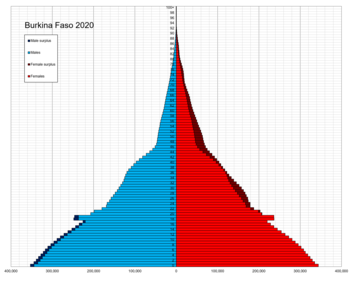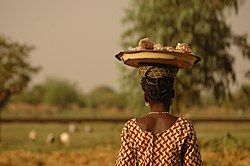
Back Население на Буркина Фасо Bulgarian Demografía de Burkina Faso Spanish Démographie du Burkina Faso French Stanovništvo Burkine Faso Croatian 부르키나파소의 인구 Korean Burkina Faso demografija Lithuanian Vahoaka ao Borkina Fasô Malagasy Демографија на Буркина Фасо Macedonian Demografia de Burkina Faso Portuguese Население Буркина-Фасо Russian
This article needs additional citations for verification. (February 2013) |

| Demographics of Burkina Faso | |
|---|---|
 Population pyramid of Burkina Faso in 2020 | |
| Population | 21,935,389 (2022 est.) |
| Growth rate | 2.53% (2022 est.) |
| Birth rate | 33.57 births/1,000 population (2022 est.) |
| Death rate | 7.71 deaths/1,000 population (2022 est.) |
| Life expectancy | 63.44 years |
| • male | 61.63 years |
| • female | 65.31 years |
| Fertility rate | 4.27 children born/woman (2022 est.) |
| Infant mortality rate | 49.42 deaths/1,000 live births |
| Net migration rate | -0.61 migrant(s)/1,000 population (2022 est.) |
| Age structure | |
| 0–14 years | 43.58% |
| 65 and over | 3.16% |
| Sex ratio | |
| Total | 0.96 male(s)/female (2022 est.) |
| At birth | 1.03 male(s)/female |
| Under 15 | 1.03 male(s)/female |
| 65 and over | 0.66 male(s)/female |
| Nationality | |
| Nationality | Burkinabe |
| Major ethnic | Mossi (52%) |
| Language | |
| Official | French |

Burkina Faso's 22.1 million people belong to two major West African cultural groups: the Gur (Voltaic) and the Mandé. The Voltaic are far more numerous and include the Mossi, who make up about one-half of the population. The Mossi claim descent from warriors who migrated to present-day Burkina Faso and established an empire that lasted more than 800 years. Predominantly farmers, the Mossi are still bound by the traditions of the Mogho Naba, who hold court in Ouagadougou.
Most of Burkina Faso's population is concentrated in the south and center of the country, with a population density sometimes exceeding 48 inhabitants per square kilometer (120 inhabitants per square mile). This population density, high for Africa, causes annual migrations of hundreds of thousands of Burkinabé to Ivory Coast and Ghana for seasonal agricultural work. About a third of Burkinabé adhere to traditional African religions. The introduction of Islam to Burkina Faso was initially resisted by the Mossi rulers. Christians, predominantly Roman Catholics, are largely concentrated among the urban elite.
Few Burkinabé have had formal education. Schooling is free but not compulsory, and only about 29% of Burkina's primary school-age children receive a basic education. The University of Ouagadougou, founded in 1974, was the country's first institution of higher education. The Polytechnic University of Bobo-Dioulasso in Bobo-Dioulasso was opened in 1995.
